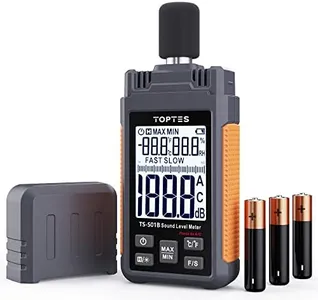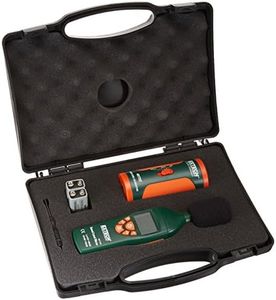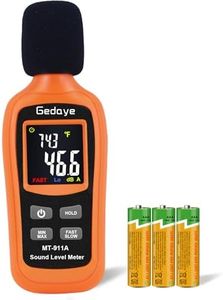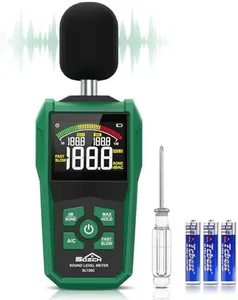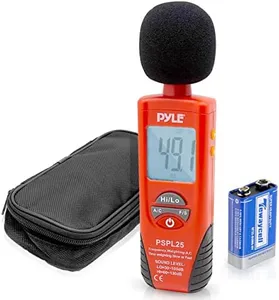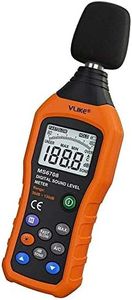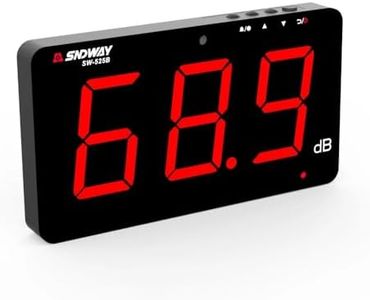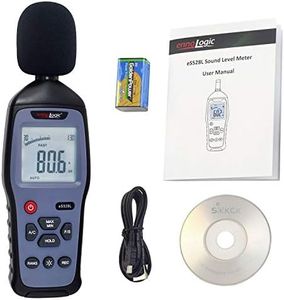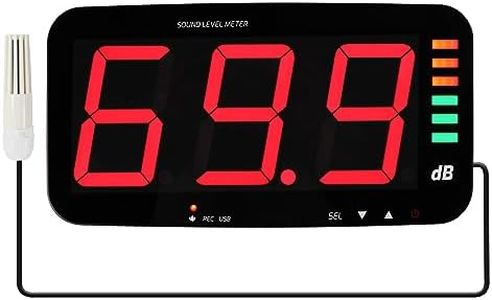10 Best Sound Decibel Meters 2025 in the United States
Our technology thoroughly searches through the online shopping world, reviewing hundreds of sites. We then process and analyze this information, updating in real-time to bring you the latest top-rated products. This way, you always get the best and most current options available.

Our Top Picks
Winner
Extech 407732-KIT Low/High Range Sound Level Meter Kit
Most important from
347 reviews
The Extech 407732-KIT is a versatile sound level meter designed for users who need a reliable way to measure noise levels across a wide range. It supports both low and high sound ranges, making it suitable for various environments, from quiet offices to louder industrial settings. One of its strong points is the triple LCD display, which not only shows sound levels but also humidity, temperature, and the date, giving more context for your measurements without extra tools. It automatically operates and lets you set alarms for specific noise thresholds, which can be helpful for monitoring compliance with noise regulations.
The device can store up to 16,000 readings and connects via USB to a PC, making data management straightforward. Its programmable features allow users to customize sampling rates and alarms either directly on the device or through a computer. As a Type 2 sound meter, it may not offer the highest precision available for professional-grade acoustic testing, though it is generally accurate enough for most industrial, workplace, or environmental noise assessments. Calibration details are not specified, so regular manual checks might be necessary to maintain accuracy.
Its compact size and light weight make it easy to carry around, but the display might be a bit small for quick reading in some conditions. This meter represents a solid choice for those needing a dependable, user-friendly tool to monitor sound levels with decent accuracy and useful extra features.
Most important from
347 reviews
REED Instruments R8050 Sound Level Meter, Type 2, 30 to 130 dB,
Most important from
139 reviews
The REED Instruments R8050 is a sound level meter designed for users who need reliable noise measurements within a 30 to 130 dB range. It meets the Type 2 standard, offering respectable accuracy of ±1.4 dB, which is suitable for many professional and general environmental noise assessments but may fall short for very precise scientific work requiring Type 1 devices. The meter features dual measurement ranges to handle both quieter and louder sounds effectively. Its 1/2" electret condenser microphone helps maintain measurement stability over time, which is important for consistent results. The backlit LCD screen makes it easy to read measurements even in low-light conditions, adding to user convenience.
The inclusion of a calibration certificate is a strong plus, ensuring users can trust the accuracy out of the box and recalibrate when needed. Accessories like a windshield and carrying case enhance usability in outdoor or variable environments. On the downside, the product dimensions and weight suggest it's somewhat bulky compared to newer, more compact models, and it lacks advanced digital features like data logging or connectivity options that some users might look for.
This meter is well suited for field technicians, maintenance workers, or environmental professionals needing a straightforward, reliable sound meter without extra bells and whistles.
Most important from
139 reviews
REED Instruments R8070SD Data Logging Sound Level Meter
Most important from
8 reviews
The REED Instruments R8070SD Data Logging Sound Level Meter is a reliable choice for measuring sound levels with high accuracy. Its ±1.0dB accuracy at 1kHz ensures precise readings, which is crucial for various applications, like industrial noise monitoring or environmental sound assessment.
The triple range measurement with a 50dB dynamic range allows for versatile use across different sound intensities. It offers both A & C frequency weighting and fast & slow response time options, making it adaptable to different measurement needs. The integrated real-time data logger with an SD memory card is a standout feature, allowing users to log and review data conveniently. Additional features like peak hold, data hold, and min/max hold provide comprehensive data management capabilities.
The package includes useful accessories like a windshield ball, a soft carrying case, and batteries, which enhance the user experience. However, the product's size and weight (9.7 x 2.7 x 1.8 inches and 1 pound) might make it slightly cumbersome for handheld use over extended periods. The metal construction ensures durability but also adds to the weight. Despite these minor drawbacks, its ease of use with automatic operation mode indicates user satisfaction. This sound level meter is a good fit for professionals needing accurate and reliable noise level measurements in various environments.
Most important from
8 reviews
Buying Guide for the Best Sound Decibel Meters
Choosing the right sound decibel meter involves understanding your specific needs and the key specifications that determine the meter's performance. Sound decibel meters are used to measure the intensity of sound in decibels (dB), which is crucial for various applications such as workplace safety, environmental noise monitoring, and audio system calibration. To make an informed decision, you need to consider several important specifications that will ensure the meter meets your requirements effectively.FAQ
Most Popular Categories Right Now
